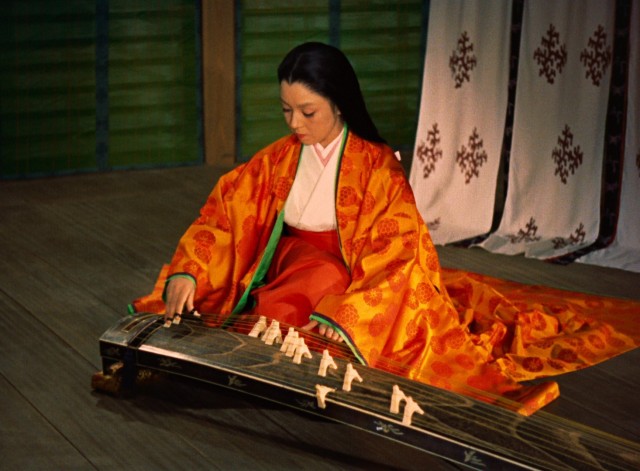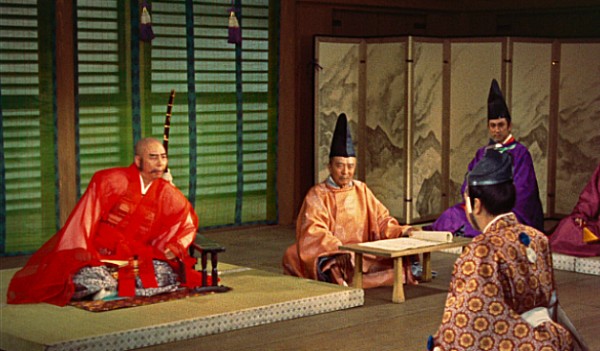
Machiko Kyō stars as a married woman being chased by an obsessed samurai in Teinosuke Kinugasa’s GATE OF HELL
GATE OF HELL (地獄門) (JIGOKUMON) (Teinosuke Kinugasa, 1953)
Japan Society
333 East 47th St. at First Ave.
Friday, January 8, $12, 7:00
212-715-1258
www.japansociety.org
 Japan Society’s January edition of its Monthly Classics series harkens back to its past with Teinosuke Kinugasa’s lush, vibrant jidaigeki film, Gate of Hell; the society sponsored the movie’s U.S. premiere at the Guild Theatre in December 1954, the first Japanese color film ever to be shown in America. Set during the twelfth-century Heiji Rebellion, the samurai drama, based on a play by Kan Kikuchi, focuses on Morito Endo’s (Kazuo Hasegawa) dark, absurd obsession with Lady Kesa (Machiko Kyō), a married woman who is very much in love with her husband, Wataru Watanabe (Isao Yamagata). After protecting Lady Kesa and helping defend his lord, Morito is offered whatever he wants by Kiyomori the Monk (Koreya Senda). The court laughs at Morito when he asks for Lady Kesa’s hand in marriage, but when Kiyomori decides to humor him, Morito opts to pursue his goal, no matter the cost, or the humiliation.
Japan Society’s January edition of its Monthly Classics series harkens back to its past with Teinosuke Kinugasa’s lush, vibrant jidaigeki film, Gate of Hell; the society sponsored the movie’s U.S. premiere at the Guild Theatre in December 1954, the first Japanese color film ever to be shown in America. Set during the twelfth-century Heiji Rebellion, the samurai drama, based on a play by Kan Kikuchi, focuses on Morito Endo’s (Kazuo Hasegawa) dark, absurd obsession with Lady Kesa (Machiko Kyō), a married woman who is very much in love with her husband, Wataru Watanabe (Isao Yamagata). After protecting Lady Kesa and helping defend his lord, Morito is offered whatever he wants by Kiyomori the Monk (Koreya Senda). The court laughs at Morito when he asks for Lady Kesa’s hand in marriage, but when Kiyomori decides to humor him, Morito opts to pursue his goal, no matter the cost, or the humiliation.

Teinosuke Kinugasa’s award-winning GATE OF HELL is filled with lush colors and beautiful cinematography
Gate of Hell, which won the Grand Prix at the 1954 Cannes Film Festival and Best Costume Design (Sanzo Wada) and a special Honorary Foreign Language Film Award at the 1955 Oscars, was beautifully restored a few years ago, its dazzling colors now jumping off the screen in a barrage of eye-catching orange, turquoise, purples, greens, and reds. Kōhei Sugiyama’s breathtaking cinematography spectacularly captures Wada’s gorgeous costumes and both the indoor and outdoor sets, the deep, detailed compositions giving the film a rousing 3D feel, from a single red flower in a green field to two rows of men lined up in a room to a battle scene in the woods. The leads will be very familiar to Japanese film fans; Hasegawa appeared in nearly three hundred movies, including Kenji Mizoguchi’s The Crucified Lovers and Kinugasa’s Jujiro and Tsukigata Hanpeita, among others, while Kyō starred in Akira Kurosawa’s Rashomon, Mizoguchi’s Ugetsu and Street of Shame, Yasujirō Ozu’s Floating Weeds, and Hiroshi Teshigahara’s The Face of Another. The Monthly Classics series continues on February 5 with Kihachi Okamoto’s The Sword of Doom.